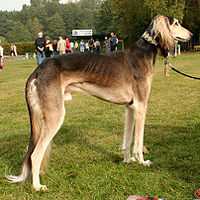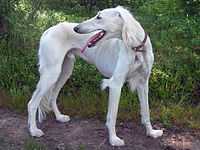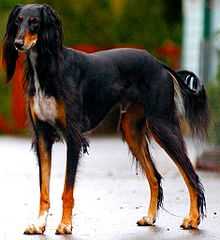Saluki
 | |||||||||||||||||||||||||
| Salukis come in a variety of coat colours. | |||||||||||||||||||||||||
| Country of origin | Middle Eastern Region | ||||||||||||||||||||||||
|---|---|---|---|---|---|---|---|---|---|---|---|---|---|---|---|---|---|---|---|---|---|---|---|---|---|
| |||||||||||||||||||||||||
| |||||||||||||||||||||||||
| Dog (Canis lupus familiaris) | |||||||||||||||||||||||||
The Saluki, Arabic: سلوقی / ALA-LC: salūqī / Persian:سلوکی,سگ تازی also known as the (Slougui) (Arabian Greyhound) (Arabischer Windhund) (Sloughi Moghrebi) (Arabian Sighthound) (Levrier Marocain ) Royal Dog of Egypt or Persian Greyhound is one of the oldest known breeds of domesticated dog. There are petroglyphs and rock arts in Golpaygan and Khomein in central Iran that shows saluki-like hounds and falcons accompanying hunters chasing preys (ca. 8000–10,000 BCE).[2] Also on the potteries found in Susa, Iran (ca. 4200 BCE) are images of saluki-like hounds chasing ibex or lying next to pools.[3][4] and from the period of the Middle Kingdom onwards, Saluki-like animals appear on the ancient Egyptian tombs of 2134 BCE. They have connections to the Avesta,[5] Bible, Koran [6] and Imperial China. Modern breeding in the west began in 1895 when Florence Amherst imported a breeding pair of Salukis from Lower Egypt and began working to popularize the breed. The first registered Salukis in the western studbook were Cyrus and Slongha Peri imported from Iran and registered with the DWZRV.[7] DWZRV also records the first litter in 1922.[8] Salukis were recognized by The Kennel Club in 1923, and by the American Kennel Club in 1929. The breed is also the mascot of Southern Illinois University Carbondale.
The Saluki is a sighthound and historically traveled throughout Iran and through Silk road with caravans and nomadic tribes over an area stretching from the Sahara to the Caspian Sea and China. They have been used to hunt quarry such as gazelles, hares and ibex (mostly in North Iran). Shaped like a typical sighthound, they come in two varieties, smooth and feathered. Though they are an independent breed that needs patient training, they are gentle and affectionate with their owners. Health issues in salukis include cancer and cardiac problems.
History


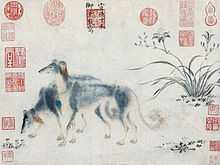
Salukis are considered to be one of the oldest dog breeds in existence. The name Saluqi has many theories. Linguistics agree the word Saluqi in Arabic is an adjective referring to where an individual was from. Sir Terence Clark [9][10] reports on four possible locations for the place Saluq including today's Yemen, Iraq and Turkey. In Persian the dog is referred to as Tazi, which means to run and in Kurdish areas Tazi is also used.[11] Also there are two more places with similar names in Northwest Iran near to the other four locations mentioned in Clark's report.
Modern science tells us the origins of all dogs are to the east in China,[12] but we do not know where the origin of the Saluki is located. All along the Silk Road his presence was known for almost as long as the dog has been domesticated, a testimony to his function as a hunter and his beauty as a companion. His image is found in many cultures.
There are petroglyphs and rock arts in Golpaygan and Khomein in central Iran that shows saluki-like hounds and falcons accompanying hunters chasing preys (ca. 8000-10,000 BC).,[2] recent excavations of the Sumerian empire, estimated at 7000-6000 BC have saluki like finds. Saluki-like images adorn pottery found in Susa.[3][4] and are found appearing on the Egyptian tombs of 2100 B.C.
The nomadic tribes spread the breed across the Middle East from Persia and Egypt, to as far east as Afghanistan and India,[13] and as far south as Sudan.[14]
They were considered to be the "Royal Dog of Egypt".[13] Salukis appear on Egyptian tombs increasingly commonly from The Middle Kingdom (2134 BC – 1785 BC) onward,[15] and have often been found mummified alongside the bodies of the Pharaohs in the Pyramids.[16] It was during the Eighteenth dynasty of Egypt that Salukis rose to their place of prominence,[17] replacing the Tesem (thought to be similar to modern Pariah dogs,[18] or a generic term for a dog).[19]
The breed is thought to be the type of dog mentioned in The Bible.[16] Salukis have appeared in medieval paintings regarding the birth of Christ, including Paolo Veronese's 1573 work The Adoration of the Magi (also known as the Adoration of the Kings), currently located at the National Gallery, London.[20][21] Veronese also painted the breed into some of his other religious work, including The Marriage at Cana and The Finding of Moses.[22]
In China examples of the breed were painted by the fifth Ming Emperor Zhū Zhānjī, known more commonly as the Xuande Emperor during the Ming Dynasty (1368–1644). The inscription on the painting reads "playfully painted [by the] imperial brush" in 1427. Additional red seals were added in later years by owners of the painting, which also reveals that the painting was in the Imperial Chinese collection in the 18th century.[23]

Iran has a long and rich visual history with the Saluki, from early representations on pottery found in Susa, miniatures painted by Master Kamal Uddin Behzad, book illustrations By Abd al-Wahhab ibn 'Abd al-Fattah ibn 'Ali (1516). It is an illustration from manuscript of Khamsa (Quintet) of Nizami, metalsmithing from the reign of the Injuid prince, Jamal al Dine Abu Is'haq, created between 1342 and 1353.[24] One of the more amazing pieces of art in Iran is the Savashi Canyon Relief, carved around 1800, commissioned by Fath Ali Shah Qajar to commemorate his hunting exploits.[25]
Today, the breed is still held in high regard throughout the Middle East, and have been hunting dogs for nobles and rulers around the region. They are considered clean by the Bedouins, and are allowed to be in women's quarters, while other dogs must be kept outside.[26] Sheik Hamad ibn Isa Al Khalifa, King of Bahrain during the 1930s, was known for a pack of Salukis that accompanied him throughout the Arab world on hunting trips. Following his death, his son Salman ibn Hamad Al Khalifa attempted to keep the lines pure-bred but they became interbred with other breeds. However, the pure-bred lines of the royal kennel were saved by the efforts of Dana Al Khalifa who was given two pure-bred puppies by the King, and about a decade later had around pure-bred Salukis registered with the Kennel Club of Bahrain.[26]
Introduction into the West

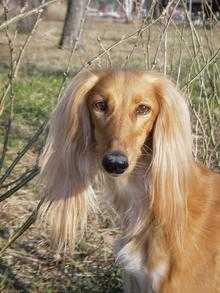
The breed was first brought to Europe in the 12th century, with troops returning from the Crusades in the Middle East, as living proof of the pilgrimage.[13][22] A dog noted as being a Gazelle Hound is featured in a painting of Henry IV, Duke of Saxony, painted in 1514, by Lucas Cranach the Elder. The dog wears a collar decorated with a scallop shell, which was the badge of the pilgrim.[22]
It was not until 1840, that the Salukis were first brought to England. Referred to as Slughis, they and the modern Sloughi were treated as the same breed,[22] however in recent years genetic tests have shown that the two breeds are not interbred.[27] The first successful modern breeding line of Salukis began in 1895, with Florence Amherst (daughter of the 1st Baron Amherst of Hackney). Having seen Salukis on a Nile tour in that year, she imported a breeding pair from the Al Salihah area of Lower Egypt. A champion of breed purity, she struggled alone for nearly three decades, and real Saluki popularity did not take hold until the early 1920s, when officers returning from the war in the Middle East and the Arab Revolt brought their pet Salukis home with them.[28]
One of these was Brigadier General Frederick Lance of the 19th Lancers, and his wife, Gladys, returned to Britain with two Salukis from Sarona, where he was stationed during the post-war occupation. The Lances were both keen hunters, and rode with their pack of dogs, including both Salukis and terriers, to course jackal and Dorcas gazelle whilst stationed in the desert. They imported a male, called Sarona Kelb, who became an influence on the breed in the West.[29]
Together, the Lances and Florence Amherst mounted a campaign for recognition of the Middle Eastern breed, that coincided with the phenomenon of "Tutmania" caused by Howard Carter's discovery of Tutankhamun’s tomb in late 1922. In 1923, the Saluki or Gazelle Hound Club was formed, and the Kennel Club granted official recognition to the breed. Popularity of Salukis dramatically increased, and the Saluki Club of America was founded in 1927, with recognition by The American Kennel Club following in 1929.[30][31]
Imports to England during the inter-war years were chiefly from areas of British military influence and commerce: Bahrain, Egypt, Transjordan, and Iraq. Both Florence Amherst and the Lances imported breeding stock from the latter two countries. Despite substantial populations of Salukis in Germany, the Netherlands, and Sweden, none of these were imported to England.[32]
English Salukis (chiefly descendants of Sarona Kelb) were exported to many countries,[33] but by the mid-1930s, interest slackened, and with the outbreak of World War II, breeding and show activities almost entirely stopped. The number of litters was minimal – just enough to keep the breed alive. Food rationing reserved all edible meat for humans, and to prevent the Salukis from dying from starvation or being killed by bombs, some owners euthanized entire kennels.[34] A small number of Saluki kennels survived the war, and along with fresh imports belonging to a second wave of soldiers returning from the Middle East, the slow process of re-establishing the breed began again.[34]
The popularity of the Saluki in the United States, according to the American Kennel Club, has remained relatively stable over the past decade, with the breed ranked 107th in 1999, had decreased to 118th in 2008, but by 2008 had increased once again to 112th.[35] Between 2000 and 2009, 1215 Salukis were registered with The Kennel Club in the UK,[36] while this does not approach the numbers of the more popular breeds,[37] it is in line with similar breeds in the Hound Group such as the Borzoi, which had 1399 puppies registered in the same period.[36] In September 2007, The Kennel Club Art Gallery's 12th exhibition celebrated the Saluki, The Saluki in Art showed a range of exhibits including terracotta and bronze works, along with contemporary artists and a range of trophies from Saluki breed clubs.[38]
Description
Salukis are "sight" hounds, which means they hunt by sight, run the quarry down, catch it, and kill or retrieve it. The normal size range for the breed is 23–28 inches (58–71 cm) high at the withers and 40–60 pounds (18–27 kg) in weight, with females being slightly smaller than males.[39] The Saluki's head is long and narrow with large eyes and drop ears.[39] The tail of the breed is long and curved.[39] It has the typical deep-chested, long legged body of the sighthounds.[40] Their coats come in a variety of colors, including white, cream, fawn, red, grizzle and tan, black and tan, and tricolor (white, black and tan).[13]
The overall appearance of the Saluki is one of grace and symmetry. There are two coat types evident in the Saluki gene pool, smooth and feathered. The feathered variety has light feathering on the back of the legs and thighs.[40] The fur on both varieties is silky to the touch,[41] and is low shedding compared to other breeds.[31]
Temperament



Historically, Salukis were used by nomadic tribes for hunting. Typical quarry included gazelles, hares, foxes and jackals.[40] In one Bedouin method of hunting hares, the hunter rides close to the quarry on a camel while holding the Saluki, which he throws towards the prey while at speed, giving the dog a running start.[42] Another method, primarily used in hunting gazelles, involved the use of a hawk to gouge out the eyes of the prey, so that a Saluki can then bring down the blinded animal.[43]
A true modern Saluki retains the qualities of hunting hounds and may seem reserved to strangers. An independent and aloof breed, but gentle and affectionate, they can be difficult to train and any such training should be gentle and patient.[44] They can get bored easily, and should not be left at home unattended for long periods.[45] Sensitive and intelligent, the Saluki should never be trained using force or harsh methods, and typically does not enjoy rough games or typical dog games such as chasing sticks. Early socialization is required to prevent timidity and shyness in later life.[44] Given their hunting instincts, they are prone to chasing moving objects.[31]
While the Greyhound is credited as being the fastest dog breed up to distances of around 800 metres (2,600 ft), both the Saluki and Whippet breeds are thought to be faster over longer distances. The 1996 edition of the Guinness Book of Records lists a Saluki as being the fastest dog, reaching a speed of 68.8 kilometres (42.8 mi) per hour.[46] Due to its heavily padded feet being able to absorb the impact on its body, it has remarkable stamina when running.[41]
Health
Hip dysplasia is uncommon in Salukis, with the breed ranking joint lowest in a survey by the British Veterinary Association in 2003. The breed scored an average of 5 points, with a score of 0 being low, while 106 is high.[47] In a 2006 breed specific survey conducted by The Kennel Club and the British Small Animal Veterinary Association Scientific Committee, responses highlighted several health issues. The primary cause of death identified was that of cancer, being responsible for 35.6% of deaths, with the most common forms being that of liver cancer or lymphoma. The secondary cause of death was cardiac related, with forms such as heart failure, or unspecified heart defects. Old age is listed as the third most frequent cause of death.[48]
Cardiomyopathy, heart murmur and other cardiac issues were present in 17.2% of responses while dermatolic conditions such as dermatitis or alopecia were reported by 10.8% of responses.[48] Salukis have an average lifespan of 12 to 14 years.[44]
References
- ↑ Mason, W. E. (1915). Dogs of All Nations. Panama-Pacific International Exposition. p. 36.
- ↑ 2.0 2.1 , No.13 in The Album of Petroglyphs in Akhale state web directory, Golpaygan, Iran.
- ↑ 3.0 3.1 , Susa Bushnell, Salukis and Ibex, at louvre.
- ↑ 4.0 4.1 , Susa Beaker, Saluki-like running dogs, Ibex, and Stork-like beards
- ↑ , Avesta Vendidad the sacred book of Zoroastrians (2300BCE - 2500BCE)
- ↑ , They ask you, [O Muhammad], what has been made lawful for them. Say, "Lawful for you are [all] good foods and [game caught by] what you have trained of hunting animals which you train as Allah has taught you. So eat of what they catch for you, and mention the name of Allah upon it, and fear Allah." Indeed, Allah is swift in account.
- ↑ , Der DWZRV ist der älteste Windhundzuchtverein in Deutschland.
- ↑ , First litter in Gernmany, 1922
- ↑ R, Sir Terence Clark.
- ↑ , Saluqi.net .
- ↑ fa:سلوکی (سگ)#.D9.86.D8.A7.D9.85, the word "Tazi" in Persian poems.
- ↑ Heredity (2011-11-23). "Heredity - Origins of domestic dog in Southern East Asia is supported by analysis of Y-chromosome DNA". Nature.com. Retrieved 2014-01-26.
- ↑ 13.0 13.1 13.2 13.3 Hale, Rachel (2008). Dogs: 101 Adorable Breeds. Andrews McMeel. p. 20. ISBN 978-0-7407-7342-6.
- ↑ Ki-Zerbo, J, ed. (1981). General History of Africa: Methodology and African Prehistory. University of California Press. p. 603.
- ↑ Allsen, Thomas T. (2006). The Royal Hunt in Eurasian History. University of Pennsylvania Press. p. 55. ISBN 978-0-8122-3926-3.
- ↑ 16.0 16.1 "Pet Fact File: Dogs". BBC Science and Nature. Retrieved 3 January 2011.
- ↑ Goldwasser (2002): p. 106
- ↑ Goldwasser (2002): p. 93
- ↑ Goldwasser (2002): p. 109
- ↑ Branigan, Cynthia A. (2004). The Reign of the Greyhound. John Wiley & Sons. p. 105. ISBN 978-0-7645-4445-3.
- ↑ "The Adoration of the Kings". The National Gallery. Retrieved 6 January 2011.
- ↑ 22.0 22.1 22.2 22.3 Leighton (1907): p. 478
- ↑ "Imperial Salukis". Harvard Magazine. Retrieved 6 January 2011.
- ↑ , Injuids vessel
- ↑ File:Qajari relief.jpg
- ↑ 26.0 26.1 Whelan, John (1983). Bahrein: A MEED Practical Guide. Lynne Rienner Pub. p. 49. ISBN 978-0-9505211-7-6.
- ↑ Crapon de Caprona, Dr. Dominique; Fritzsch, Dr. Bernd. "Sloughi, Saluki, Saluqi… Genetic Data Help Separate Semantics From Evidence". Dogs in Review. Sloughi Fanciers Association. Retrieved 7 January 2011.
- ↑ Duggan (2009): p. 36
- ↑ Duggan (2009): p. 127–128
- ↑ Duggan (2009): p. 150
- ↑ 31.0 31.1 31.2 "AKC Meet the Breeds: Saluki". American Kennel Club. Retrieved 7 January 2011.
- ↑ Duggan (2009): p. 154
- ↑ Duggan (2009): p. 181
- ↑ 34.0 34.1 Duggan (2009): p. 242
- ↑ "AKC Dog Registration Statistics". American Kennel Club. Retrieved 7 January 2011.
- ↑ 36.0 36.1 "Comparative Tables of Registrations for the Years 2000 - 2009 Inclusive (Hound Group)" (PDF). The Kennel Club. Retrieved 7 January 2011.
- ↑ "Comparative Tables of Registrations for the Years 2000 - 2009 Inclusive (Gundog Group)" (PDF). The Kennel Club. Retrieved 7 January 2011.
- ↑ "The Kennel Club Art Gallery presents the Saluki in Art". The Kennel Club. 15 August 2007. Retrieved 7 January 2011.
- ↑ 39.0 39.1 39.2 Palika (2007): p. 342
- ↑ 40.0 40.1 40.2 Case, Linda P. (2005). The Dog: Its Behavior, Nutrition, and Health. Wiley-Blackwell. p. 26. ISBN 978-0-8138-1254-0.
- ↑ 41.0 41.1 Alderton, David (2006). Top to Tail: The 360 Degrees Guide to Picking Your Perfect Pet. David & Charles. p. 71. ISBN 978-0-7153-2589-6.
- ↑ Vine, Peter (1997). Natural Emirates: Wild Life and Environment of the United Arab Emirates. Trident Press. p. 233. ISBN 978-1-900724-02-9.
- ↑ Ash, Edward (1934). This Doggie Business. pp. 155–156.
- ↑ 44.0 44.1 44.2 O'Neil, Amanda (2006). What Dog?. Interpet Publishing. pp. 162–163. ISBN 978-1-84286-117-2.
- ↑ "Saluki". The Kennel Club. Retrieved 6 January 2011.
- ↑ Murgai, R. P. (1996). Hand Book of Dogs. New Age International. p. 108.
- ↑ "Breed Average Hip Scores". British Veterinary Association. Vetrica. Retrieved 7 January 2011.
- ↑ 48.0 48.1 "Summary Results of the Purebred Dog Health Survey for the Saluki Breed". The Kennel Club. Retrieved 7 January 2011.
- Leighton, Robert (1907). The New Book of the Dog. Cassell and Company.
- Goldwasser, Orly (2002). Prophets, Lovers and Giraffes. Harrassowitz Verlag. ISBN 978-3-447-04590-2.
- Palika, Liz (2007). The Howell Book of Dogs: The Definitive Reference to 300 Breeds and Varieties. John Wiley & Sons. ISBN 978-0-470-00921-5.
- Duggan, Brian Patrick (2009). Saluki: The Desert Hound and the English Travelers Who Brought It to the West. McFarland & Co Inc. ISBN 978-0-7864-3407-7.
External links
| Wikimedia Commons has media related to Saluki. |
- Saluki on the Open Directory Project


